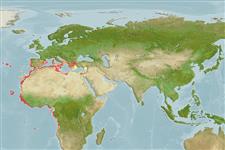Environment: milieu / climate zone / depth range / distribution range
البيئة
بحري القاع; غير مهاجرة; نطاق العمق 1 - 150 m (Ref. 34024). Subtropical; 42°N - 15°S
Eastern Atlantic: including the Mediterranean. Probably south to Ascension Island.
الحجم / وزن / العمر
Maturity: Lm ? range ? - ? cm
Max length : 20.8 cm TL ذكر/ مختلط الجنس; (Ref. 6347)
الأشعة الظهرية الناعمة (المجموع) : 37 - 39. Eel-like, moderate to shallow body depth; cardiform teeth present but restricted to upper jaw symphysis; swim bladder constricted forming two chambers; lacking enlarged dentary or premaxillary fangs, dentary diastema, pelvic fins and swim bladder rockerbone (Ref. 34024). Possesses a free, movable maxilla (Ref. 6347).
Common species (Ref. 34024). Adults typically live as commensals in the gut of shallow-water holothurians, Holothuria tubulosa and Stichopus regalis (although some deep-water records exist, see Ref. 6347). Prejuveniles (tenuis larvae) probably inhabit the same host species while the vexillifer and egg-rafts are planktonic. The fish may partly protrude or entirely leave its host at night to feed on small fish and benthic invertebrates. Reproduction noted in July-September. (Ref. 4741).
Life cycle and mating behavior
Maturities | التكاثر | Spawnings | Egg(s) | Fecundities | Larvae
It is not yet established whether spawning is seasonal or sporadic in carapids. Eggs elliptical and planktonic (Ref. 6355).
Nielsen, J.G., D.M. Cohen, D.F. Markle and C.R. Robins, 1999. Ophidiiform fishes of the world (Order Ophidiiformes). An annotated and illustrated catalogue of pearlfishes, cusk-eels, brotulas and other ophidiiform fishes known to date. FAO Fish. Synop. 125(18):178p. Rome: FAO. (Ref. 34024)
IUCN Red List Status (Ref. 130435)
استخدامات بشرية
مصائد: غير ذات اهمية
أدوات
تقارير خاصة
Download XML
مصادر علي الأنترنت
Estimates based on models
Preferred temperature (Ref.
123201): 14.8 - 27.6, mean 19.4 °C (based on 324 cells).
Phylogenetic diversity index (Ref.
82804): PD
50 = 0.5312 [Uniqueness, from 0.5 = low to 2.0 = high].
Bayesian length-weight: a=0.00102 (0.00046 - 0.00225), b=3.06 (2.88 - 3.24), in cm total length, based on all LWR estimates for this body shape (Ref.
93245).
مستوى غذائي (Ref.
69278): 4.0 ±0.63 se; based on food items.
Fishing Vulnerability (Ref.
59153): Low vulnerability (11 of 100).
Nutrients (Ref.
124155): Calcium = 67 [15, 198] mg/100g; Iron = 1.05 [0.40, 4.30] mg/100g; Protein = 17.3 [14.9, 19.7] %; Omega3 = 0.31 [0.13, 0.70] g/100g; Selenium = 21.2 [4.7, 60.6] μg/100g; VitaminA = 16.9 [5.6, 51.0] μg/100g; Zinc = 0.785 [0.404, 1.528] mg/100g (wet weight);
